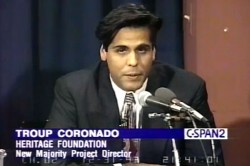Living
UPDATED: GLAAD president resigns under pressure; Six Board members out
Board member criticized in flap once worked for anti-gay Heritage Foundation


Troup Coronado, a former AT&T executive and current GLAAD board member, once directed minority outreach at the anti-gay Heritage Foundation. (Screen capture from CSPAN video archives)
UPDATE: According to Politico, six members of the GLAAD Board of Directors are out, including American Teachers Federation President, Randi Weingarten.
GLAAD President Jarrett Barrios resigned Saturday after a tumultuous two weeks in which he was caught up in an uproar over the organization’s involvement in the proposed merger of AT&T and T-Mobile.
Barrios came under fire from the LGBT blogosphere after an appearance on the Michelangelo Signorile show by former GLAAD board of directors co-chair Laurie Perper, who questioned a series of official statements released by Barrios’ office supporting telecommunications giant AT&T.
“The GLAAD Board has received Jarrett Barrios’ resignation letter and discussed this among other topics on our call. We expect at our next Board meeting set for Wednesday to reach a conclusion on all issues so that Mr. Barrios can begin to help The Board manage transition and bring on his successor,” the organization said in a statement.
But the story didn’t end with Barrios’ resignation, as several other LGBT organizations were pulled into the fray, either by close association to AT&T, a paper trail of their own similar letters or a connection to a GLAAD board member at the center of the controversy, Troup Coronado.
Coronado occupied seats on the boards of no less than four LGBT organizations in 2009, at the time the letters to the FCC began to emerge from these organizations’ head offices.
In 2009, when the letters containing the pro-AT&T language — later found to be opposing net neutrality — were delivered to the FCC, Coronado sat on the board of directors for GLAAD and the Equality California Institute, and served as dinner co-chair of the National Gay and Lesbian Chamber of Commerce, according to Politico and other media reports this week. Each of these organizations sent seemingly innocuous, nearly identical letters to the FCC containing language supporting the telecom industry’s position against net neutrality.
The organizations, except for Equality California and the National Gay and Lesbian Chamber of Commerce, sent follow-up letters to the FCC retracting their original letters after the matter was brought to their attention.
In addition, the Human Rights Campaign refused to support the telecom position by joining the sign-on letter, though Coronado also sat on HRC’s Business Council at the time. Coronado was later removed from the body in March 2010.
Meghan Stabler, a transgender LGBT activist, educator and Business Council member, said though Coronado’s departure was unrelated to the controversy surrounding the letter, his participation on the body was a factor.
“Each year the HRC Business Council reviews member participation and HRC Workplace Project objectives, doing so allows members to retire from the council and new members to be on-boarded as needed,” she said.
Coronado — who once worked for Orin Hatch — is turning out to be a controversial background player in the world of LGBT philanthropy. As reported last week in the Blade, both OpenSecrets.org and the Washington Post have questioned Coronado’s conduct in one way or another over the years.
After an investigation into Coronado’s past, the Blade has discovered that a Troup Coronado who graduated from the University of Texas at Austin the same year as AT&T’s Coronado, and whom an anonymous source confirmed is the same person, appeared in several CSPAN videos from 1991-1993 as a representative of the anti-gay conservative think-tank the Heritage Foundation. Jeremy Hooper of the GoodAsYou blog was able to identify several instances of media outlets covering the Heritage Foundation opposition to pro-LGBT legislation in the 1980s and 1990s, and Heritage has been vocal in opposing same-sex marriage over the past decade. The CSPAN video gives Coronado’s title at the organization as Director of the New Majority Project.
The Heritage Foundation declined to comment about the purpose of this now-defunct program, but according to a July 14, 1991 Newsweek article by Charles Lane, titled “Defying the stereotypes,” the project is defined as the body’s “minority outreach program.”
A search of the Heritage Foundation archives reveals transcripts of presentations given on behalf of the program including controversial conservative figures such as Errol Smith, who would go on in 1996 to serve as vice chair of the California Civil Rights Initiative, which successfully pushed for a ballot measure prohibiting the use of so-called “Affirmative Action” at California public institutions. Coronado was present for Smith’s February 1992 speech before Heritage Foundation members on racism in the African-American community, and was referenced several times in the text of the speech.
In addition, CSPAN’s website features videos of Coronado acting as president of the Washington chapter of the Ex-Students Association of his alma mater, as well as another video introducing disgraced radio host Armstrong Williams, who later apologized for taking $240,000 from the Bush administration to promote the Department of Education’s “No Child Left Behind” law on his television and radio appearances.
Coronado was once an executive at AT&T, as well as a lobbyist for AT&T’s former parent company, BellSouth. Coronado left his position at AT&T late last year to launch a consultant firm — where it is alleged one of his most prominent clients is AT&T. The company reportedly tasked Coronado with securing LGBT organizational support for the AT&T/T-Mobile merger.
Coronado could not be immediately reached for comment.
When reached by phone, Jim Carroll, interim executive director of Equality California — who came into the position far after the controversy broke — says the fallout from the Oct. 12, 2009 letter was a wake-up call for the organization.
“I’m not denying the genesis of the letter was a request from AT&T,” Carroll told the Blade. “There were and there are no policies and procedures that would require the executive director to vet such a request … I would assume that this is a wake-up call for all of us to carefully consider requests of support for any of our allies — it doesn’t have to be a corporate ally.”
The letter was never amended, as Carroll was unaware of the letter at the time, and the issue is only now coming to his attention.
Carroll confirms that Coronado remains on the board of the California Equality Institute, despite the controversy, though Carroll says that in his six years at the organization, he believes there has never been an incident where a board member with a corporate relationship has ever asked the organization to take a position on any issue that would be considered a conflict of interest, including Coronado.
However, Carroll has yet to hear from Coronado himself about the controversy, despite requesting a conversation with the board member days ago.
Another organization that recently revealed it too was duped by the AT&T sample text, was the National Gay and Lesbian Task Force, which has revamped its policies and procedures for vetting what are known as “sign-on letters,” from colleague organizations.
“I signed them and I take the responsibility for the mistake of issuing both the 2009 letter and the January 5, 2010 letter,” Rea Carey, the Task Force’s executive director, told the Blade.
The Task Force issued a correction on Jan.14, after colleagues familiar with the net neutrality issue called Carey’s attention to the true meaning of the AT&T suggested language.
Carey clarified, “we get offered sample text, and language for sign-on letters,” by organizations seeking the Task Force’s support on matters of government policies and legislation, but “rarely get requests from corporations to write letters.”
“Almost always the request comes from a colleague organization — someone in ‘Labor,’ maybe a pro-choice organization, one of the civil rights organizations — those requests almost always come to me, and I forward them on to our Policy staff, and they assess them, and determine whether or not its appropriate for us to sign on to any particular letter,” Carey said.
However, when she saw the letter came from corporate partner, AT&T, Carey forwarded the sign-on letter to staff in charge of corporate relationships to review the request.
“That was the mistake I made,” she admits. “Our procedure now, no matter who on staff gets a request for a sign-on,” Carey clarified, “if there is a policy matter involved, our policy staff are involved in the full analysis and the decision on how to proceed.”
That procedural change was a direct result of the oversight on the Jan. 5 anti-net neutrality letter.
Fausto Fernos hosts the LGBT podcast, “Feast of Fun” with his partner, Marc Felion, where Jarrett Barrios first began giving conflicting statements about the origin of the GLAAD FCC letter.
“Most of our advocacy groups have a profound lack of understanding of how the Internet works, and why it’s valuable in the fight, and what it means to every single LGBT individual,” Fernos said. “We don’t value all of the amazing content that’s being created.”
Fernos became passionate about promoting this story because he believes that the AT&T position on net neutrality will create barriers to LGBT advocacy in the future.
Real Estate
Celebrate the power of homeownership this Fourth of July
Owning a home is powerful act of self-determination

This Fourth of July, celebrate more than independence: celebrate the power of LGBTQ+ homeownership. Explore resources, rights, and representation with GayRealEstate.com, the trusted leader in LGBTQ+ real estate for over 30 years.
Home is more than a house: it’s a symbol of freedom
As the fireworks light up the sky this Fourth of July, LGBTQ+ individuals and families across the country are not just celebrating the nation’s independence — they’re celebrating personal milestones of freedom, visibility, and the right to call a place their own.
For many in the LGBTQ+ community, owning a home represents more than stability — it’s a powerful act of self-determination. After generations of discrimination and exclusion from housing opportunities, more LGBTQ+ people are stepping into homeownership with pride and purpose.
Why homeownership matters to the LGBTQ+ community
While progress has been made, LGBTQ+ homebuyers still face unique challenges, including:
- Housing discrimination, even in states with legal protections
- Limited access to LGBTQ+ friendly realtors and resources
- Concerns about safety and acceptance in new neighborhoods
- Lack of representation in the real estate industry
That’s why the Fourth of July is a perfect time to reflect not just on freedom as a concept, but on how that freedom is expressed in the real world — through ownership, safety, and pride in where and how we live.
Finding LGBTQ+ Friendly Neighborhoods
One of the top concerns for LGBTQ+ buyers is whether they’ll feel safe, accepted, and welcome in their new neighborhood. Thanks to evolving attitudes and stronger community support, many cities across the U.S. now offer inclusive, affirming environments.
Some of the best cities for LGBTQ+ home buyers include:
- Wilton Manors, Fla. – A vibrant LGBTQ+ hub with strong community ties
- Palm Springs, Calif. – A longtime favorite for LGBTQ+ homeowners
- Asheville, N.C. – Progressive and artsy, with growing LGBTQ+ visibility
- Portland, Ore. – Inclusive, eco-conscious, and diverse
- Philadelphia, PA – Rich in history and LGBTQ+ community leadership
When you work with an LGBTQ+ friendly realtor, you get insight into more than property values — you get a real perspective on where you’ll feel most at home.
Navigating the real estate process with confidence
Whether you’re a first-time gay homebuyer or preparing to sell your home as an LGBTQ+ couple, it’s essential to understand your rights and options. Here are a few key tips:
1. Work with a trusted LGBTQ+ real estate agent
Representation matters. A gay realtor, lesbian real estate agent, or LGBTQ+ friendly agent understands the unique concerns you may face and advocates for you every step of the way.
Use GayRealEstate.com to connect with LGBTQ+ real estate agents near you. For over 30 years, we’ve helped LGBTQ+ buyers and sellers find their ideal home and a professional who respects their identity.
2. Know your legal protections
While federal law (via the Fair Housing Act and Supreme Court rulings) prohibits housing discrimination based on sexual orientation or gender identity, enforcement can vary by state. Make sure to research:
- State-level housing discrimination laws
- Local LGBTQ+ protections and resources
- What to do if you experience discrimination during a transaction
3. Secure inclusive financing
While most lenders follow fair lending rules, it’s smart to seek out banks or credit unions with LGBTQ+ inclusive policies and a history of non-discriminatory lending practices.
4. Plan for the future as a family
For same-sex couples, especially unmarried partners, it’s vital to review how you’ll hold the title, designate beneficiaries, and plan your estate.
Ask your agent or attorney about:
- Joint tenancy with right of survivorship
- Living trusts
- Powers of attorney and healthcare proxies
Selling a home as an LGBTQ+ homeowner
If you’re listing your home, working with a gay-friendly real estate agent ensures your identity and story are honored — not hidden — in the process.
Highlight:
- Your community connections
- Your home’s role in creating a safe space
- Local LGBTQ+ resources to attract like-minded buyers
Showcasing the full value of your home includes sharing what it meant to live there authentically and safely.
Your home, your freedom
The Fourth of July reminds us that freedom isn’t just an abstract idea — it’s lived every day in the spaces where we find comfort, love, and belonging. For the LGBTQ+ community, the right to own and thrive in a home is part of the larger journey toward full equality.
At GayRealEstate.com, we believe every LGBTQ+ person deserves:
- A safe place to live
- A community that welcomes them
- An advocate in the home buying or selling process
Ready to make a move?
Whether you’re dreaming of your first home, upgrading with your partner, or selling a space that helped shape your identity, GayRealEstate.com is your trusted partner. With our nationwide network of gay realtors, lesbian real estate agents, and LGBTQ+ friendly professionals, we make your journey smooth, respectful, and informed.
Visit GayRealEstate.com to:
- Search LGBTQ+ friendly homes
- Connect with inclusive real estate agents
- Access free guides for buyers and sellers
- Protect your rights and get expert advice
This Fourth of July, celebrate more than independence — celebrate your freedom to live, love, and own with pride.

Did you melt like the Wicked Witch of the West this week?
As summer temperatures rise, keeping your home or apartment cool during a heat wave can become both a comfort issue and a financial challenge. One of the most effective ways to keep a home cool is to prevent heat from entering in the first place. Sunlight streaming through windows can significantly raise indoor temperatures. Consider the following solutions:
• Close blinds or curtains during the hottest parts of the day. Blackout curtains or thermal drapes can reduce heat gain by up to 30%.
• Install reflective window films to block UV rays and reduce solar heat without sacrificing natural light.
• Use outdoor shading solutions such as awnings (yes, the ones you removed because they were “dated”) and shutters to limit direct sunlight.
Fans are a cost-effective way to circulate air and create a wind-chill effect that makes rooms feel cooler.
• Ceiling fans should rotate counterclockwise in the summer to push cool air down.
• Box fans or oscillating fans can be placed near windows to pull in cooler evening air or push hot air out.
• Create a cross-breeze by opening windows on opposite sides of your home and positioning fans to direct airflow through the space.
• For an extra cooling effect, place a bowl of ice or a frozen water bottle in front of a fan to circulate chilled air.
To optimize natural ventilation, open windows early in the morning or late in the evening when outdoor temperatures drop. This allows cooler air to flow in and helps ventilate heat that built up during the day.
Appliances and electronics generate a surprising amount of heat. To reduce indoor temperatures:
• Avoid using the oven or stove during the day; opt for no-cook meals, microwave cooking, or grilling outside.
• Run heat-producing appliances like dishwashers and clothes dryers in the early morning or late evening.
• Unplug electronics when not in use, as even standby power can add heat to your space.
• Switching to energy-efficient LED lightbulbs can also reduce ambient heat compared to incandescent lighting.
If you do use an air conditioner, maximize its effectiveness by:
• Setting it to a reasonable temperature—around 76–78°F when you’re home and higher when you’re away.
• Cleaning or replacing filters regularly to maintain airflow and efficiency.
• Sealing gaps around doors and windows to prevent cool air from escaping. (Didn’t we all have a parent who said, “Close the door. You’re letting all the cool out?”)
• Using a programmable thermostat to optimize cooling schedules and reduce energy use.
If it is not cost-prohibitive, adding insulation in attics and walls can greatly reduce heat transfer. Solar panels that reflect heat can also help, as well as offset the cost of their installation. Adding weatherstripping around doors and windows, sealing cracks, and using door sweeps can make a significant difference in keeping heat out and cool air in.
Natural and eco-conscious methods can also help cool your home.
• Snake plants, ferns, or rubber trees can improve air quality and slightly cool the air through transpiration.
• White or reflective roof paint can reduce roof temperatures significantly.
• Cooling mats or bedding can make sleeping more comfortable without cranking up the A/C.
For renters or those who can’t make permanent modifications, there are still plenty of ways to keep cool.
• Use portable fans and A/C units instead of built-in systems, making sure they are the correct size for your space.
• Removable window film or static cling tinting can reflect heat without violating your lease.
• Install tension rod curtains or temporary blackout panels instead of hardware-mounted window coverings.
• Add draft blockers and weatherstripping tape that can be applied and removed without damage.
• Cover floors with light-colored rugs to reflect heat rather than absorb it.
• If allowed, use temporary adhesive hooks to hang reflective materials or light-filtering fabrics over windows.
Even if your space is warm, you can still take steps to help your body stay cool.
• Wear light, breathable fabrics like cotton or linen.
• Stay hydrated and avoid caffeine or alcohol during peak heat hours.
• Take cool showers or use damp cloths on your neck and wrists to bring your body temperature down.
Keeping your home or apartment cool in the summer doesn’t have to be expensive or energy-intensive. With a few adjustments such as blocking sunlight, optimizing airflow, using fans effectively, and making renter-friendly upgrades, you can create a more comfortable indoor environment while keeping energy bills in check.
Valerie M. Blake is a licensed Associate Broker in D.C., Maryland, and Virginia with RLAH @properties. Call or text her at 202-246-8602, email her at DCHomeQuest.com, or follow her on Facebook at TheRealst8ofAffairs.
Real Estate
The world’s on fire and D.C. is on sale (sort of)
Prices are up, but then again, nothing makes sense anymore

ICE is disappearing people, revered government agencies are shuttering, and who knows if we’ll be in World War III next week? But can you believe prices in D.C. are actually still up 6.3% since last year? It doesn’t make sense, and perhaps that does make sense, because nothing seems to make any sense any more.
That said, there are some parts of our market that are truly suffering. The interest rates, which have been up, up, up for about four years now, are the ongoing rain on our market’s military parade. Combine that with 75,000 federal employees taking a buyout nationwide, and DOGE cuts eliminating around 40,000 federal jobs in the District (per estimates by the D.C. CFO), not to mention thousands of other job losses in non-governmental organizations due to funding and program cuts, and you’ve got a case of uncertainty, and downright unaffordability in the pool of otherwise would-be buyers.
This has had a marked impact on properties that starter-home buyers and low- to mid-level employees would otherwise buy, most notably condominium and cooperative apartment units. These properties have already slowed in our market thanks to the profound impact that higher interest rates have had on their monthly carrying costs—pair that with job insecurity, and a lot of condos are proving to be very difficult to sell indeed.
So how is the average sale price up in our market?
The increase is almost entirely due to the resounding strength of the single-family home market, especially in upper Northwest D.C., where it is still quite common to see bidding wars, even on properties pushing past the $3M mark. It seems that buyers in that echelon are less impacted by a few percentage points in the interest rate, and less concerned about their job security. Notably, those buyers are often married with children and have an absolute need for more space, must stay in the area due to one spouse’s job, or the kid’s friend group, regardless of whether the cost of owning is thousands of dollars more per month than it would have been in 2020 or 2021. The continued appreciation in these neighborhoods defies imagination.
So, what to do if you are not one of those lucky enough to be shopping for a $3M home? The short answer: wait. If you want more space, rent your current place out and learn the joys of being a landlord while someone else pays your mortgage. Need the equity from your current home to buy your next place? Get a home equity line of credit, or loan, and pull the equity out of your current place to buy the next one. Or—and I have never recommended this before in 21 years of being a Realtor—rent for a few years. Sure, I’d love to list and sell your condo so you can climb the real estate ladder, but it might just be a waste of time, money or both if you could just ride out this storm and sell in a DOGE-less future.
All this said, there are some condos that seem to be immune from this recent negative news. Anecdotally, it feels like it’s the truly special ones that do just fine no matter the market. Our recent listing in Capitol Hill had a view from every one of its 15 windows of the Supreme Court. Sold in five days with six offers. Another condo was on the top two floors of a townhouse and had the coolest black wood floors that gleamed like a grand piano. Sold in four days at full price.
So, all is not for naught if you have a condo or home in an area that people want to be in, with nice space, light, amenities and a certain je ne sais quois. And, as long as we have a democracy in a few years, my experience says our market will be back, stronger than ever, really soon.
David Bediz is a Realtor and mortgage loan broker for the Bediz Group LLC and Home Starts Here, LLC. Reach him at [email protected].
-

 U.S. Supreme Court1 day ago
U.S. Supreme Court1 day agoSupreme Court to consider bans on trans athletes in school sports
-

 Out & About1 day ago
Out & About1 day agoCelebrate the Fourth of July the gay way!
-

 Maryland4 days ago
Maryland4 days agoSilver Spring holds annual Pride In The Plaza
-

 Opinions4 days ago
Opinions4 days agoSupreme Court decision on opt outs for LGBTQ books in classrooms will likely accelerate censorship










